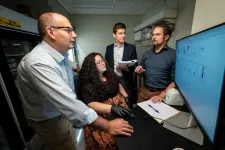Racial and ethnic differences in gut microbiome emerge at 3 months old
The new study analyzed thousands of samples from more than 700 children between birth and 12 years of age
2023-08-17
(Press-News.org) Gut microbiome variation associated with race and ethnicity arises after three months of age and persists through childhood, according to a new study published August 17th in the open access journal PLOS Biology by Elizabeth K. Mallott of Washington University in St. Louis, US, Seth Bordenstein of Pennsylvania State University, US, and colleagues.
Human microbiome variation has been linked to the incidence, prevalence and mortality of many diseases and is known to associate with race and ethnicity in the United States. However, in this context race and ethnicity are considered proxies for inequitable exposure to social and environmental determinants of health due to structural racism. When these microbiome differences arise during development and how they correlate with early life experiences, including racism, has been unclear.
In the new study, researchers studied data from 8 previous studies which, in total, included 2,756 gut microbiome samples from 729 children between birth and 12 years of age. 17.2% of samples were from non-White individuals, and 14.3% of samples were from Hispanic individuals.
A machine learning model that analyzed the data identified variability associated with race and ethnicity at or shortly after 3 months of age and could distinguish participants’ race and ethnicity with 87% accuracy based on their microbiomes. Some of the bacterial species most important in this prediction were also associated with breastfeeding and delivery method (vaginal vs Caesarean section). Of the 57 types of bacteria that varied in abundance among children of differing self-identified racial categories, 19 were previously identified as differentially abundant between Black and White adult individuals.
“Notably, our findings do not support race- or ethnicity-associated variation appearing at birth or shortly after, when mother-to-infant and other mechanisms of vertical microbial transmission are expected to be strongest,” the authors say. “Instead, external factors are most likely shaping race- and ethnicity-associated microbiome variation at or shortly after three months. Our results highlight the impetus to increase the diversity of individuals included in studies in the microbiome sciences and support the call for studies investigating how structural racism and other structural inequities affect microbiome variation and health.”
Mallott says, “The differences that we see are not present at birth, or even shortly after. Only two of the 82 microbes that differ along the lines of either race or ethnicity are microbes that are maternally transmitted. The vast majority are all microbes that we acquire from the environment.”
Bordenstein adds, “The analysis presented in this paper highlights that human microbiome studies have an urgent imperative to prioritize diversity and the social sciences in research from early life onward. We want to eventually translate diverse microbiome discoveries into shaping the future of health precision, policy and equity across the diversity of all of us.”
#####
In your coverage, please use this URL to provide access to the freely available paper in PLOS Biology: http://journals.plos.org/plosbiology/article?id=10.1371/journal.pbio.3002230
Citation: Mallott EK, Sitarik AR, Leve LD, Cioffi C, Camargo CA Jr, Hasegawa K, et al. (2023) Human microbiome variation associated with race and ethnicity emerges as early as 3 months of age. PLoS Biol 21(8): e3002230. https://doi.org/10.1371/journal.pbio.3002230
Author Countries: United States
Funding: see manuscript
END
[Attachments] See images for this press release:


ELSE PRESS RELEASES FROM THIS DATE:
2023-08-17
Environmental regulators and other organizations should do more scientific experimentation to inform natural resource policy, according to an international group of economists that includes University of Wyoming researchers.
In a new paper in the prestigious journal Science, the economists say more frequent use of up-front experiments would result in more effective environmental policymaking in areas ranging from pollution control to timber harvesting across the world.
“Although formal experimentation is a cornerstone of science and is increasingly embedded in nonenvironmental social programs, it is virtually absent in environmental ...
2023-08-17
The city of Gatineau is planning a tramway network that will link up with Ottawa, where the Light Rail Transit (LRT) continues to be bogged down by major mishaps. With Montreal’s new Réseau express métropolitain (REM) light transit system experiencing its own hiccups to start, how can cities looking to incorporate mass transport systems successfully launch such endeavors while avoiding project failures and years of misfortune?
New research from a University of Ottawa professor suggests project leaders not overlook the “F” word.
Telfer School of Management professor Lavagnon Ika found a lack of full appreciation ...
2023-08-17
Almost 66 million years ago, an asteroid struck the Earth, killing all non-avian dinosaurs and allowing mammals to dominate.
But just how did we evolve from rat-like creatures running between the feet of dinosaurs to take over their ecological niches? Dr. Kendra Chritz, assistant professor in the UBC department of earth, ocean and atmospheric sciences, aims to find out.
Dr. Chritz is co-leading a new multi-million-dollar research project to learn how ecosystems and organisms recover after a catastrophic, climate-changing event. She explains in this Q&A that clues may lie in the fossilized teeth of mammals.
Why don’t we know much about how mammals ...
2023-08-17
Scientists have discovered an additional potential cause of the genetic mutations that result in rare conditions such as Huntington’s disease (HD).
The neurodegenerative diseases, which also include most spinocerebellar ataxias (SCAs), are known to be caused by an expansion in the CAG (cytosine-adenine-guanine) repeats within a gene that in turn leads to an expanded polyglutamine (polyQ) tract in a protein.
Such diseases are inherited, given that the expansion of CAG repeats in a gene can be passed down the generations.
Previously, it had been thought the damage in these genetic diseases was caused solely by increased protein aggregate toxicity.
However, ...
2023-08-17
ITHACA, N.Y. -- Current methods can vastly overestimate the rates that malaria parasites are multiplying in an infected person’s blood, which has important implications for determining how harmful they could be to a host, according to a new report.
The findings also have consequences for understanding the evolution of traits that lead to drug resistance, how quickly a parasite might spread through a population, and for evaluating the effectiveness of new vaccines.
The study, “Extraordinary Parasite Multiplication Rates in ...
2023-08-17
Female Genital Mutilation (FGM) is a leading cause of death in the countries where it is practised, with over 44,000 additional women and young girls dying each year, a new study reveals.
FGM accounts for more deaths in these countries than any cause other than enteric infections – usually resulting from consuming contaminated food or water – respiratory infections, or malaria and remains legal in five of the 28 countries where it is most practiced.
Researchers are calling for FGM to be made illegal Mali, Malawi, Chad, Sierra Leone, and Liberia, given that legal change can lead to cultural change. They also say that efforts must be ...
2023-08-17
While for physical systems in equilibrium, thermodynamics is an invaluable tool to make predictions about their state and behaviour without needing access to many details, finding similarly general and concise descriptions of non-equilibrium systems is an open challenge. A paradigmatic example of non-equilibrium systems are turbulent systems, which are ubiquitous both in natural and synthetic settings, from blood flow to airplanes. Especially wave turbulence is known to be a very difficult problem, challenging to calculate and not easy to measure, as waves of so many different wavelengths are involved.
Now scientists based at the University ...
2023-08-17
(MEMPHIS, Tenn. – August 17, 2023) St. Jude Children’s Research Hospital scientists, in collaboration with the Institute of Environmental Science and Research (ESR) Limited, found that immune cells present in people months before influenza (flu) infection could more accurately predict if an individual would develop symptoms than current methods which primarily rely on antibody levels. The study found certain immune cells were associated with increased protection, while other immune cells were associated with increased susceptibility to developing symptoms after catching ...
2023-08-17
Ann Arbor, August 17, 2023 – According to the results of a new study in the American Journal of Preventive Medicine, published by Elsevier, exposure to interpersonal violence throughout childhood or adulthood increases an individual’s chance of developing adult-onset diabetes by more than 20%. Data showed the risk level is similar among adult males and females and lower income Black and White Americans.
Lead investigator Maureen Sanderson, PhD, Department of Family and Community Medicine, Meharry Medical College, explained, “While previous research has linked exposure to interpersonal violence with a higher risk for developing ...
2023-08-17
Chandra Mohan, Hugh Roy and Lillie Cranz Cullen Endowed Professor of biomedical engineering, is reporting the first use of the powerful imaging mass cytometry (IMC) to examine the kidneys of patients with lupus (systemic lupus erythematosus), an autoimmune disease that can affect multiple organs and become fatal, and to diagnose lupus nephritis (LN) in those patients.
LN is a severe inflammation of the kidneys and a major cause of death in lupus patients. Up to 60% of SLE patients will develop renal symptoms with 5–20% of those patients progressing to end stage kidney disease within 10 years.
IMC can showcase ...
LAST 30 PRESS RELEASES:
[Press-News.org] Racial and ethnic differences in gut microbiome emerge at 3 months old
The new study analyzed thousands of samples from more than 700 children between birth and 12 years of age




